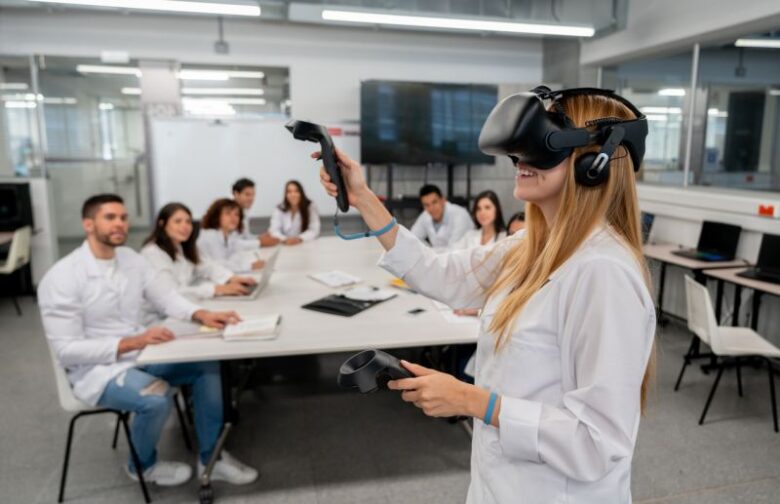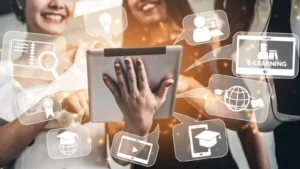Virtual reality (VR) is no longer just a futuristic vision of games and entertainment. It has entered schools and is transforming the way children learn and how teachers teach. VR brings abstract concepts to life by placing students in simulated worlds. This makes lessons more engaging. This transformation transforms traditional classrooms into vibrant, hands-on learning centers, allowing students to learn at a deeper level.
Using Visuals to Understand Complex Concepts
Some topics and concepts are difficult to grasp using traditional methods. VR allows teachers to break these complex topics down into more visual and understandable components. For example, students studying physics, biology, or chemistry can observe small processes or dangerous experiments in a safe virtual environment. This facilitates learning and reduces the mental burden of understanding complex problems. Information presented in 3D is easier to see and understand.
Empowering Students to Learn at Their Own Pace
By offering students unique experiences, VR allows them to learn at their pace. Not all students learn in the same way or at the same pace. VR-based educational tools allow teachers to tailor lessons to each student’s learning style. VR allows students to choose their own learning path, whether they’re returning to a module or moving on to a more challenging subject. This personalization is especially helpful for children with special needs, as it makes the learning environment more user-friendly.
Promoting Collaboration and Communication Among Students
VR isn’t just a platform for independent exploration; it also promotes collaborative learning. Students can work on projects, solve problems, or communicate with other students in a shared virtual space, regardless of their physical location. This not only encourages teamwork but also improves communication skills, as students have to express their ideas and listen to others in a virtual environment. VR classrooms can bring students together from around the world, allowing people to better understand each other’s cultures and collaborate globally.
Preparing Teachers for the School of the Future
Using VR in schools also benefits teachers. They can use VR for professional development, meaning they learn how to apply the technology in the classroom through hands-on exercises. Training simulations can prepare teachers for real-world situations, such as classroom management or addressing special education challenges. VR also provides teachers with a safe platform to practice and improve their teaching skills, enabling them to better respond to the changing needs of their students.
Promoting Safe and Practical Skill Development
VR offers students in vocational and technical schools a safe way to practice real-world skills without fear of injury or costly mistakes. Students can gain authentic experiences in virtual environments that simulate real-life situations, whether performing surgery, repairing an engine, or operating machinery. This hands-on learning experience builds students’ confidence and skills, helps prepare them for the workforce, and ensures they are safe and utilize resources optimally during their studies.
Stimulating Critical Thinking and Creativity
Virtual worlds stimulate students’ creativity and creative thinking. VR helps them develop critical thinking by placing them in situations where they must make decisions, solve problems, and generate new ideas. For example, students can conduct their experiments in a virtual science lab and learn from their successes and failures. By studying history, they can see events from multiple perspectives, helping them understand and empathize with people with different viewpoints.
Preparing Students for a Technological Future
As businesses increasingly rely on technology, it’s crucial that students learn how to use the tools of the future. Schools are using virtual reality (VR) in the classroom to help students improve their technological and digital literacy. These skills will be valuable in universities and the job market, as online work, remote work, and collaboration using digital simulations become the norm. Using VR in education makes learning more engaging and equips students with the skills they need to succeed in today’s job market.
Accelerating Language and Cultural Education
Language learners often find it difficult to immerse themselves in real-world situations and apply their skills to real-world situations. VR addresses this problem by placing students in authentic environments, allowing them to practice speaking, listening, and comprehension in a natural way. French students can “wander through Paris,” converse with French speakers, or visit cultural sites. All of this helps them learn the language and better understand the local culture. This level of immersion makes learning faster, more engaging, and more practical.
Conclusion
Virtual reality is changing the way we learn in ways that were unthinkable just a few years ago. VR is transforming the way students and teachers engage with knowledge, making learning more engaging, unraveling challenging topics, enabling personalized learning, and lowering the barriers to education. It provides students the opportunity to learn, collaborate, and grow in an immersive environment, sparking their curiosity and creativity. As the technology continues to develop and becomes more accessible, VR will have an even greater impact on education, making it a more inclusive, effective, and progressive way of learning for everyone.
FAQs
1. What is VR in the classroom?
VR in education refers to the use of realistic, simulated environments to enhance teaching and learning.
2. How does VR help students learn better?
VR makes learning more engaging, helps students understand better, and enables them to learn by doing, all of which contribute to better academic performance.
3. Is VR suitable for all learning levels?
Yes, VR can be used in elementary, university, and vocational schools.
4. Are there any challenges with using VR in schools?
Some challenges include high costs, insufficient technical training for teachers, and the need for robust internet and hardware infrastructure.
5. Can VR replace conventional teaching methods?
VR is a wonderful complement, but it’s most effective when combined with other methods for a more comprehensive learning experience.




